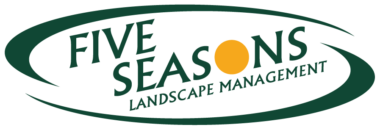With spring comes yard work. It’s inevitable. But it can also be satisfying watching all your hard work blossom and bloom around you. An important part of Columbus, Ohio, landscaping that most people don’t think about in detail is mulch. After all, what is mulch? And why should you mulch your garden and landscaping?
Male gardener working in the garden doing the mulching at the start of spring kneeling in a flowerbed spreading the mulch around a tree trunk.

We already know mulch is decorative. In fact, it’s a relatively quick way to improve the look of your entire yard. Just spread mulch around your flower beds, trees and shrubs and, voilà! Now your yard looks amazing. But which type of mulch should you buy? After all, it comes in different materials, colors, and sizes.
What is mulch?
Basically, any material that covers soil is considered mulch. This includes hard elements like pebbles and stones to softer ones like compost and straw.
What are the benefits of mulch?
At Five Seasons Landscape Management, we believe soil should never be left exposed. Ground covering protects soil from erosion, helps retain moisture, and maintains the soil’s temperature. All of which are beneficial for plant growth.

- Controls soil erosion: from wind and rain.
- Retains moisture: to reduce the amount and frequency of watering.
- Maintains soil temp: to reduce stress on your plants.
Why you need to get rid of weeds before mulching:
Not only are weeds ugly, they also steal valuable nutrients from your plants. Aggressive weeds can be downright destructive, taking over your yard or garden. In a previous article, we discussed whether you should kill weeds or pull them. Either way, make sure to get rid of weeds before applying mulch.
Organic mulch vs. inorganic mulch

Organic mulch is made from natural materials that break down over time. Examples include wood bark, compost, straw, and grass. Inorganic mulch consists of gravel, stones, and pebbles. Both types of mulch help deter weeds and maintain moisture, but organic mulch can provide added nutritional benefits to your plants.
It’s time to mulch your garden and landscaping.
What is organic mulch?
Organic mulch is good for your soil because it adds nutrients as it breaks down and decays over time.
- Wood bark: Bark is…well, bark. It comes in large pieces, decays slowly and should only be used on top of the soil (not mixed in).
- Wood chips: Smaller than bark, they consist of chopped pieces of branches and plant matter. They retain water better and break down faster than bark.
- Shredded wood: Decomposes the quickest. Its fine texture works well to control weeds and cover pathways.
- Compost: Too fine to be a top mulch because it does not suppress weeds effectively, compost is best mixed into soil for added nutrition.
- Straw: Commonly used in vegetable gardens, a thick layer of pine straw can suppress weeds and add acid to the soil. Just watch out on windy days as some may blow away.
- Grass Clippings: Free and readily available, only use small amounts of green grass that have not been fertilized or treated for weeds.
What is inorganic mulch?
If low maintenance is a deciding factor in your landscaping then inorganic materials like pebbles, stones or gravel are right for you. These rocks help keep in moisture, block weed growth, and can look pretty in flower beds. Unfortunately, however, there are no nutrient benefits. Pumice rock is commonly used in flower beds because it’s lightweight and porous (retains moisture).
Why is hardwood mulch popular?
Hardwood mulch is one of the most popular types of mulch used today. It’s affordable, easy to apply, and can be conveniently purchased in bulk or by the bag.
three different types of mulch offered for sale at a garden supply center
What are the different types of hardwood mulch?

Not only are there varying sizes and shapes of wood mulch, there are also different types of wood used.
- Cedar mulch: Cedar oil is natural insect repellant (termites hate it) but it may also repel the “good” garden bugs like worms and ladybugs. It lasts a long time and smells great!
- Cypress mulch: The bark and the wood of the cypress tree are ground up into chips or shredded. They stay in place and smell pleasant.
- Colored mulch: Comes in black, brown, red, and specialty colors. But don’t worry, the dye is non-toxic and safe. Colored mulch is usually a combo of wood chips and shredded pieces.
- Natural mulch: No color is added to this wood-based mulch and it has the same benefits of the others.
- Hardwood chips: This mulch consists of chopped up pieces of hardwood bark. It decomposes faster due to its small size so it’s great for areas that you till often.
- Fresh wood chips: Want to make your own mulch? If you have a wood chipper/spreader you can recycle broken limbs and debris and turn it into mulch.
How do I apply mulch?
First, remove all weeds. Next, add compost or other nutrients and work them into the soil. Finally, apply a 3-inch layer of mulch, making sure to keep away from plant stems and tree trunks.
How much mulch do I need to buy?
There are many online mulch calculators, like this one provided by Better Homes & Gardens. You can also contact Five Seasons Landscape Management to find out more on mulch types and amounts.
We are a Columbus, Ohio, landscaping company certified and licensed by the Ohio Department of Agriculture. We serve residential and commercial customers in landscape design and maintenance services.
